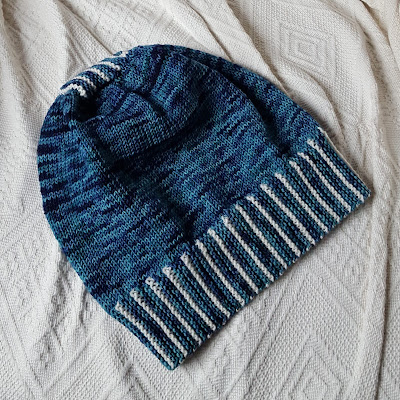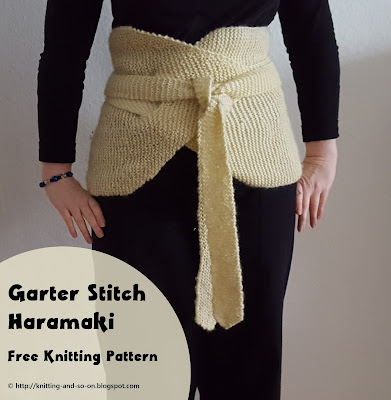As with many of my patterns, I don't give exact stitch counts. For the decrease rows, for example I will ask you to count your stitches and decrease to 64 stitches over the next 3 rounds. If you don't like these kinds of instruction, you probably won't like the pattern.

This work by Knitting and so on is licensed under a Creative Commons Attribution-NonCommercial-ShareAlike 4.0 International License.

Dansk / Danish: A danish version of this pattern is also available. It was translated by MarianneHo (Ravelry name) and can be found here.
Materials
- a total of about 80-90 grams of Sport weight yarn - about 70-80 grams of the main color (MC) and about 10 grams of the contrast color (CC)
- 3mm needles (for the brim or ribbing)
- 3.5mm or 3.75mm needles (for the main part of the hat) - I used circulars for the main part of the hat and dpns for the crown, but you can used dpns throughout
- a crochet hook for provisional CO
- scrap yarn for provisional CO
- a stitch marker
- a tapestry needle to weave in ends
Techniques
- Provisional CO: My favorite method for a provision CO is the crochet provisional CO - it is shown in this Youtube video by New Stitch a Day.
- Three Needle Bind Off: https://youtu.be/Ph93jWSzTa0
- Pick up and knit: As shown in one of these YouTube-videos: https://youtu.be/4XtGL8vJf-g, https://youtu.be/htAHtNnuE7Q or https://youtu.be/oUPhLYkC0Fw
Instructions
Brim
With smaller needles:
Provisionally CO 16 sts
Row 1 (MC): k all stitches
Row 2 (MC): k all stitches
Row 3 (CC): k all stitches
Row 4 (CC): k all stitches
Row 5 (MC): k all stitches
Row 6 (MC): k all stitches
Repeat these 6 rows until the piece is long enough to fit around your hat when stretched.
Put the stitches from the provisional CO on a knitting needle and do a three needle BO. Your piece should look similar to picture 1.
Cut both yarns.
Main Part
With MC and bigger needles pick up and knit 4 stitches per 3 garter stitch ridges. Join in round and place end-of-round-marker. Knit about 15 cm of stockinette rounds (or until the hat is "slouchy" enough for you).
Count your stitches and over the next 3 rounds, decrease the number of stitches to 64 stitches.
(Just for example, here are my stitch counts: I had 132 stitches and decreased every 4th stitch in the first round (about 99 stitches left), every 4th stitch in the second round (75 stitches left) and then distributed the necessary 11 decreases equally in the third round.)
Crown
Distribute the 64 left stitches on 4 needles. Your piece should look similar to picture 2. (If you only have circulars, you may want to put stitch markers after every 16 stitches).
Now you will work with the first 16 stitches and the adjoining stitches on both sides.
Row 1 (CC): k15, k2tog (i.e. the last stitch on the first needle and the first stitch on the adjoining needle), turn
Row 2 (CC): k15, k2tog (i.e. the last stitch of your row and the first stitch on the adjoining needle, turn
Row 3 (MC): k15, k2tog (again, the last stitch on your "working needle" and the next stitch on the adjoining needle), turn
Row 4 (MC): k15, k2tog, turn
Row 5 (MC): k15, k2tog, turn
Row 6 (MC): k15, k2tog, turn
Repeat rows 1-6 four more times (after a few rows, your piece should look similar to picture 3), then knit rows 1 and 2 one more time.
Now you should have a total of 2x16 stitches left - one needle of the 16 sts that you just worked in CC, and another needle of 16 stitches that haven't been worked with since the main part.
Turn the hat inside out (see picture 4) and with MC do a three-needle bind off.
Weave in ends.













